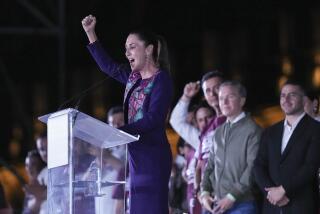Tense City Reflects Electoral Split
OAXACA, Mexico — In the months leading up this nation’s presidential election, the contest was often described as one between two very different Mexicos: the prosperous and the poor.
On Sunday, both were fully on display in this deeply polarized city.
For the last several weeks, this picturesque regional capital known for its rich, indigenous culture has been the scene of a massive teachers’ strike, a bitter showdown that has left scores injured, streets barricaded with metal sheets and the historic city center strewn with trash and rubble and covered in graffiti.
The confrontation pits thousands of aggrieved teachers and their supporters demanding better wages and working conditions against state Gov. Ulises Ruiz. During one melee last month, police beat demonstrators with truncheons, according to Mexico’s national human rights commission.
As millions of their countrymen headed to the polls, some demonstrators discounted the election as a sham that underscored the inequities in Mexican society and said they would not vote. Meanwhile, hundreds of other Oaxacans flocked to polling stations to cast their ballots. At one precinct, the line of people waiting to vote wrapped around three-quarters of a city block.
En route to the polls, some stopped to discuss their votes and register their support or disapproval of the strike.
“It has affected us economically and given a bad image of Oaxaca,” said businessman Serafin Barranca, 49. He said he had voted for conservative candidate Felipe Calderon of the National Action Party.
Maria Dolores Corres, 49, who drove to the polling station in a black Jeep Liberty with her mother and cousin, dismissed the claim of some strikers and their supporters that open class warfare was breaking out in Oaxaca.
“Those are lies,” she said. “We’re captives in our own city.”
But Rosa Velasquez, 26, a lawyer who belongs to a civic organization that supports the teachers, says many poor Oaxacans don’t believe their lives will improve no matter which of the three principal candidates is the next president.
“They know the same thing arrives again and again and again,” she said. “All three will rob them.”
Velasquez said she planned to vote to exercise what she called her “free expression.” But she said that the demonstrations, which have drawn support from regional farmers, housewives, taxi drivers and other unions, were being driven by the extreme poverty in which many here live, and other fundamental social problems the election won’t solve.
The social tensions in Oaxaca surrounding the election mirror those in other parts of the country. Several weeks ago, violence broke out in San Salvador Atenco, in Mexico state, between street vendors and police. The incident has inspired a campaign theme and a rallying cry for some Mexicans.
The contrast between Mexico’s poor and the upper- and newly prosperous middle classes is sharp in this mountainous southern state. Oaxaca city’s vibrant arts scene, magnificent ruins and other charms attract thousands of U.S. and European tourists every year. But the state, with a large indigenous population spread across scores of small villages, is one of Mexico’s most troubled and underdeveloped areas, where many farmers scratch out a living plowing their fields with oxen.
As tensions have escalated, the demonstrators have called for the governor to resign, and ripples of their protest have reached the federal government hundreds of miles away in Mexico City, with no resolution in sight.
“There are two Mexicos and effectively there are two Oaxacas. There’s an underground Oaxaca that the tourists don’t see, an exploited Oaxaca,” said Javier Aluz Mancera, 25, a member of a Marxist-Leninist group that is supporting the strikers.
Though his group opposed an electoral boycott, fearing it would favor Calderon of the PAN or Roberto Madrazo of the Institutional Revolutionary Party (PRI), Mancera said he thought that leftist candidate Andres Manuel Lopez Obrador and his Democratic Revolution Party (PRD) were “not a solution to anything.”
Another demonstrator, Victor Luis, 25, said he planned to vote in the election but that he also planned to vote with his feet by leaving Mexico for good. A farmworker, Luis said he hoped to return to the United States soon. He has crossed illegally before at Tijuana, and has labored in the fields of California. In Mexico, he said, the wages are very low and the workload very heavy. Across the border, he said, it’s the opposite.
In many parts of this city, life is maintaining its usual rhythms. On Saturday, markets were full of shoppers and people milled about the parks and plazas. Sunday Mass went on as normal in the city’s cathedral.
But the city’s central square was a sea of blue-and-gray plastic tarpaulins being used as shelters. Signs inscribed with political slogans covered banks and hotels: “Ulises Assassin” and “Go Home Tourist, Oaxaca anti-capitalist.” Several restaurants and at least one hotel around the square stood shuttered and empty. The manager of one restaurant declined to speak with a reporter about the situation.
The one thing many here appeared to agree on was that Sunday’s balloting for the presidency appeared more transparent than elections for state offices. Several voters remarked on the lack of pressure and intimidation tactics by local political parties, especially the PRI, which ruled Mexico for seven decades and is still dominant locally.
“The elections for the state are horrible,” said Roberto Arnaud, who owns a publicity company.
More to Read
Sign up for Essential California
The most important California stories and recommendations in your inbox every morning.
You may occasionally receive promotional content from the Los Angeles Times.











